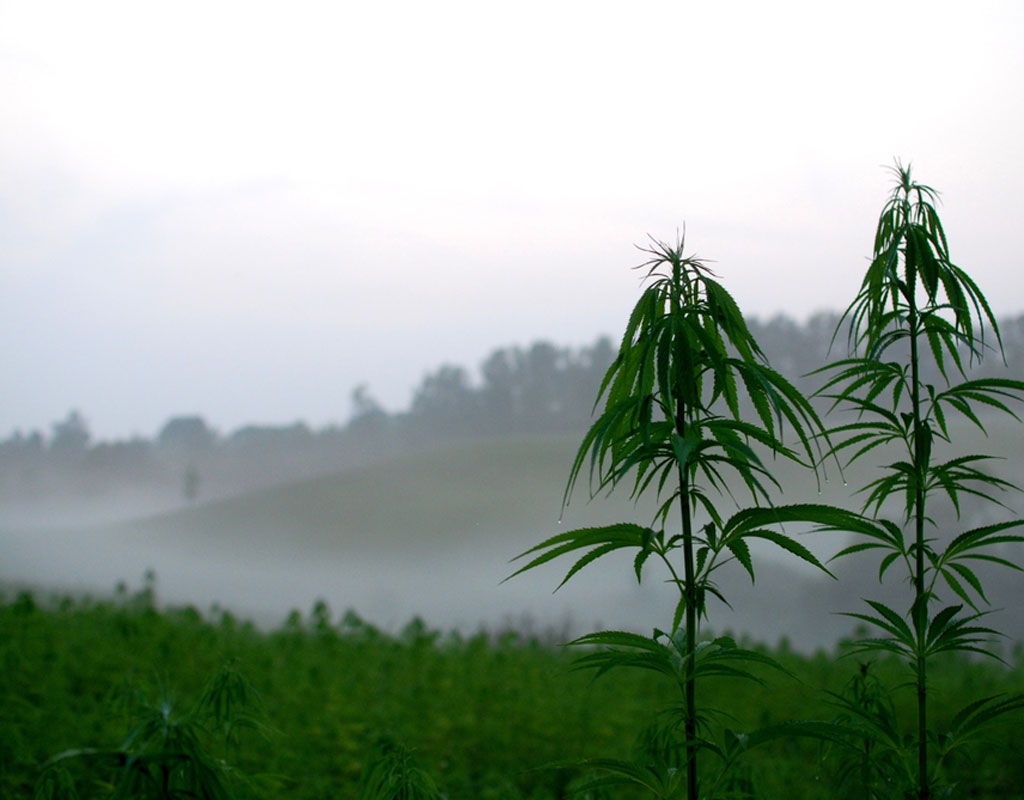It was a coincidence really.
A piece of gum shaped into what looked like a cannabis bud given to an unsuspecting but ever-curious Stuart Tomc at the door of the 2013 Natural Products Expo East in Baltimore, Maryland.
He was used to trying the newest, weirdest thing: Kava kava from Vanuatu, million-year-old dirt—the guy who helped bring omega-3 fish oil to the mainstream supplement market was always looking for the next big natural health movement. That was his job at Nordic Naturals, and he was happy there. But this time, this gum, was different. It changed Tomc’s career and life. He describes the experience as “transformative.”

Photo courtesy of CV Sciences
“It began to ground me in a way I have not known before. I’ve now since heard from many other people that a little bit of modulation through the hemp extract makes people just comfortable in their own skin.”
Tomc is no stranger to the natural wellness field. He first worked at a juice bar in Chicago as a teenager. Then with Dr. Oregano when oil of oregano was first introduced to the market. He was charged with informing the public on this new wellness discovery, called omega-3, which you can now find on nearly any grocery store shelf. But in the mid-90s, with its oversimplified infomercials and celebrity endorsements, the sales formula didn’t work anymore, not with Gen-Xers brandishing mobile phones and a doubtful eye.
“Over the last 15 years, the nutrition industry was forced to evolve how it communicated information, and I got to be a part of it,” he says. “The entire Zeitgeist was shifting from generalizations to personalizations, shifting power from manufacturers to consumers.”
Tomc’s personal experience sparked a commitment to dedicate the remainder of his career toward hemp and the endocannabinoid system. He now serves as vice president of human nutrition for CV Sciences, a San Diego-based CBD company launched in 2012 that operates in two avenues: CBD as a pharmaceutical and CBD as hemp-based consumer finished products. This distinction represents a clear stance the company takes regarding the future of CBD.
CV Sciences predicts three distinct “swim lanes” that will forge the future accessibility of hemp, CBD and cannabinoids. The importance of choosing your lane is crucial—both as a consumer and as a company. Someone looking to alleviate mild forms of stress, for example, isn’t the same consumer as a desperate parent of a child with a rare and extreme form of epilepsy. Companies creating CBD sports recovery drinks are quite different from companies looking to create a CBD-based pharmaceutical to aid those with PTSD.
“CBD is one molecule; it’s one of over 100 cannabinoids, and it’s one of 500 different compounds in the hemp cannabis plant,” Tomc says. “The term CBD has become synonymous with hemp, which has become synonymous with marijuana, which has become synonymous with THC, which has somehow become conflated with synthetic cannabinoids at exactly the same time, and so we’re all totally confused.”

Rather than overgeneralizing as the best CBD product, the best CBD company, the best CBD manufacturer, CV Sciences has staked a claim in two of the three supposed swim lanes. The claim is strong. The publicly traded company is responsible for one of the most popular CBD brands on the market: PlusCBD Oil, which was recently the first CBD product used in an 11-person study regarding PTSD. The company has also invested in a robust safety and toxilogical assessment that positioned PlusCBD Oil as the first CBD company to secure GRAS (generally regarded as safe) self-determination.
CV Sciences attributes its sustained growth to education, empowering the consumer to decide what best serves his or her individual needs. There’s enough pie for everyone, Tomc says, as long as you swim in your own lane.
Why Now?
Discovered less than 30 years ago, the endogenous cannabinoid system (named after the plant that aided the discovery and now known as the endocannabinoid system) is perhaps most simply described as a bridge between the brain and the body.
Tomc says we were primed for a discovery like the endocannabinoid system. Combating modern stress in all its various and complex forms remains a priority, which is difficult considering there is no accepted single definition for stress. According to the American Psychological Association, chronic stress is linked to six leading causes of death, and more than 75 percent of all physician visits in 2014 (the latest available data) was for stress-related issues. It’s going to take more than a night of lavender bath bombs to get there. CV Sciences believes hemp CBD may be a solution.

In the ’90s, Tomc was responsible for educating a market that wanted instant results from fad diets, miracle anti-aging skin cream, focus-enhancing pills. People wanted to be better, stronger, younger, faster. Of course, products aimed at these goals will never go away, but a shift was happening. Rather than changing themselves, people just wanted to feel better in their own skin. They’re stressed and worn out and tired of the constant push. They wanted to simply feel normal again.
How do you sell a product to a person who isn’t looking for another product promising to change their life?
For the first time, companies must face multiple generations who haven’t known a time without access to seemingly endless amounts of information. A teenager with an internet connection and some common sense can spot overhyped, overpromising products without much help.
How do you sell a new product to a person who lives in a time of fake news spotters and Twitter warriors?
The key, Tomc says, is not to focus on the product alone, but what it could mean for the bigger picture of health and wellness.
“Hemp and its remarkable versatility is nothing new,” he says. “What’s new is the discovery of the system that coordinates our immune and nervous systems to keep us healthy and balanced.”
Stay in Your Lane
The CBD industry is in a Wild West stage that allows all sorts of bad actors to play leading roles in the conversation. With minimal regulation, companies seeing gold are able to rush the market with haphazard products at best. Unwitting consumers fall prey to marketing jargon about plant sourcing, premium plant parts and the power of terpenes.

In one analogy, Tomc compares this swirl of jargon to a $200 bottle of wine and a $6 box of wine. They both have a basic percentage of alcohol—just like a basic percentage of CBD content in a bottle of gummies. And then you have the co-factors that make it expensive, such as fruity terpenes and an oak barrel. Both wines will have relatively the same effect on the body, but one might be more enjoyable than the other. Of course, enjoyment is subjective.
His point: We’re talking about the wrong things—things we still know very little about. The focus, as a consumer, a company, a people, should be to continue learning about the endocannabinoid system, decide which lane we fall in, and let the regulatory systems of government do their jobs.
“In order to realize a $40-billion product category we are going to have to clean up the bad actors and the Wild West environment,” says Joe Dowling, the company’s CEO. “We’re trying to be the adult and make sure that we’re truly taking the high road on everything.”

Photo courtesy of CV Sciences
Beyond GRAS self-determination, CV Sciences commits to education by offering online education tools for both consumers and retail employees; an education team that travels to various retail locations to help inform consumers; a largely unmatched scientific and medical advisory board; and partner- ships with key players such as the Rodale Institute, Council for Responsible Nutrition and the American Herbal Products Association, among others. And it’s eager for the inevitable regulation because of what it could mean.
“If we do not protect pharma [to investigate] what this plant has to offer, we’re going to deprive our relatives,” Tomc says. “I want our grandparents, who may not feel as comfortable as other people, to be able to eventually get products that target the endocannabinoid system to give them many of the benefits that they’re looking for with potentially lower side effects.”
This article originally appeared in the August/September 2019 issue of CBD Snapshot. Never miss a story; subscribe today




